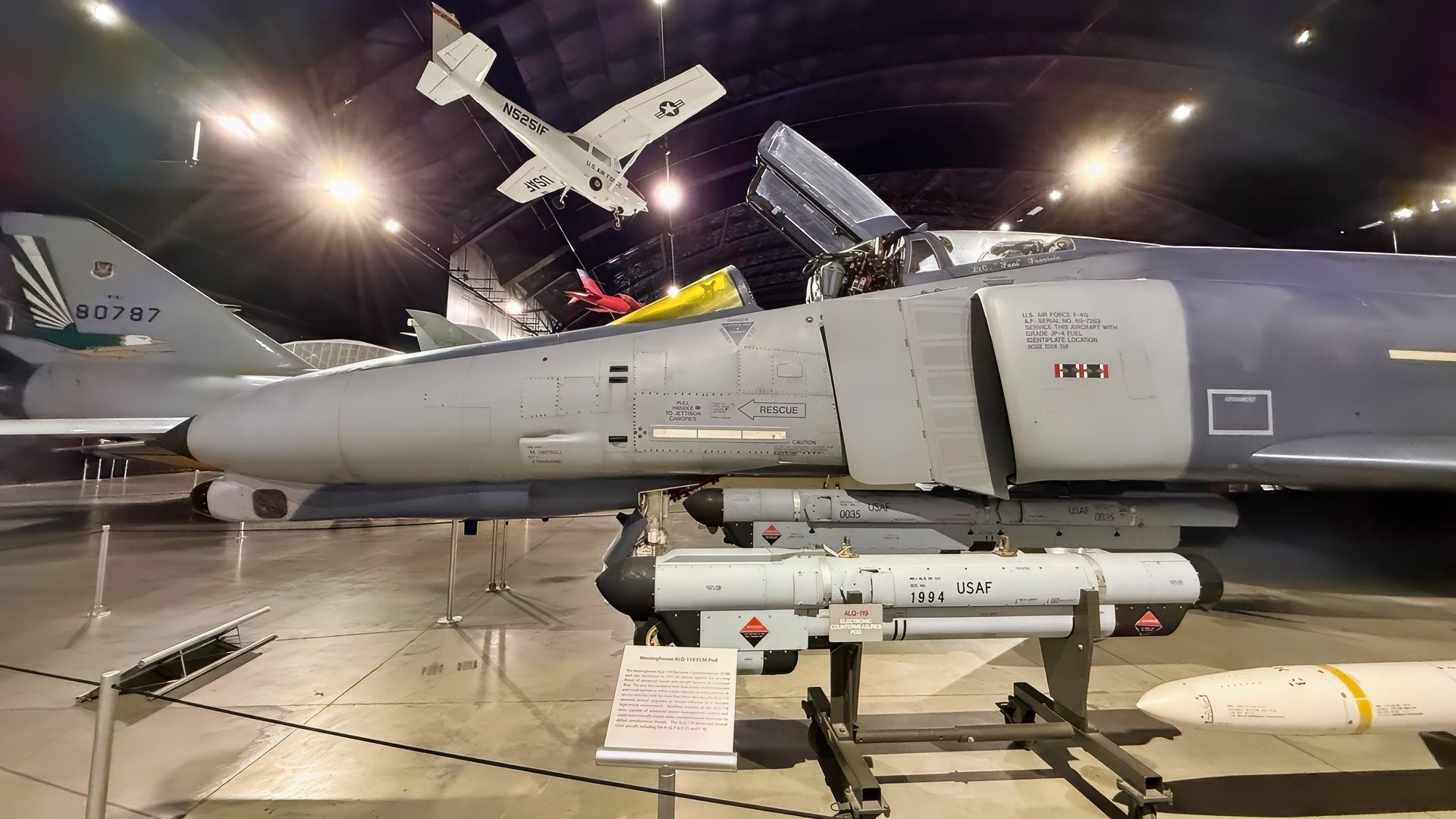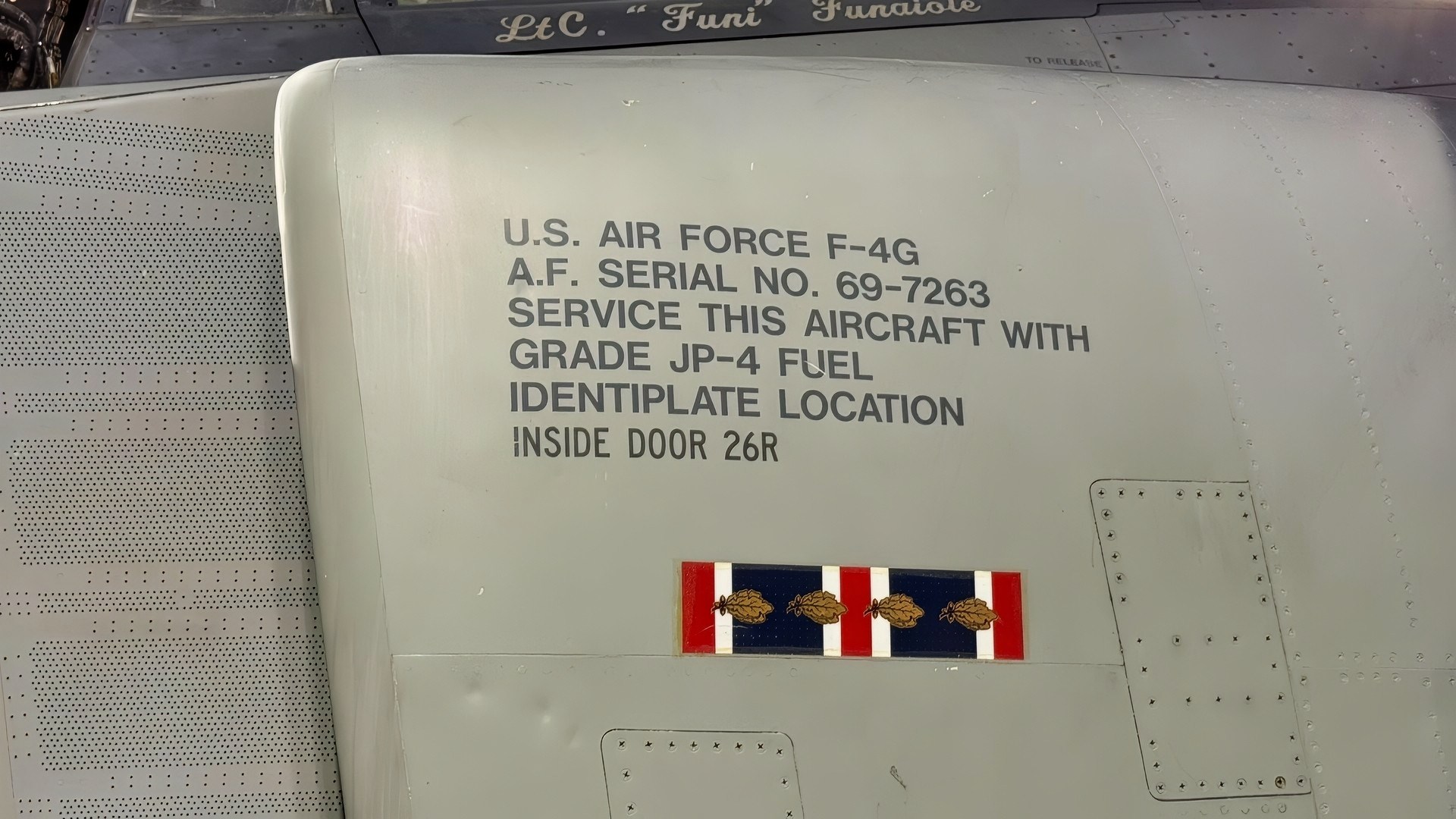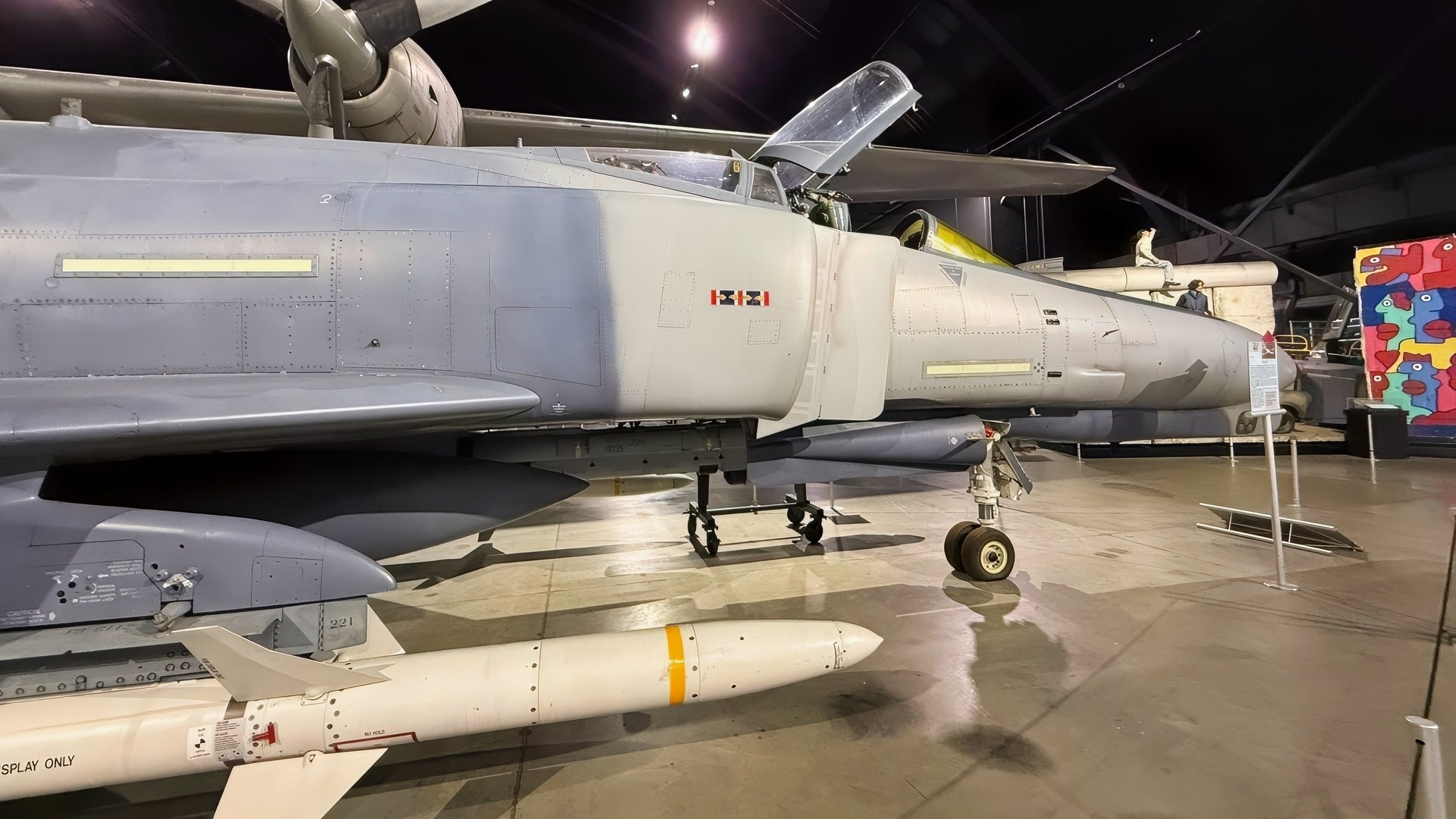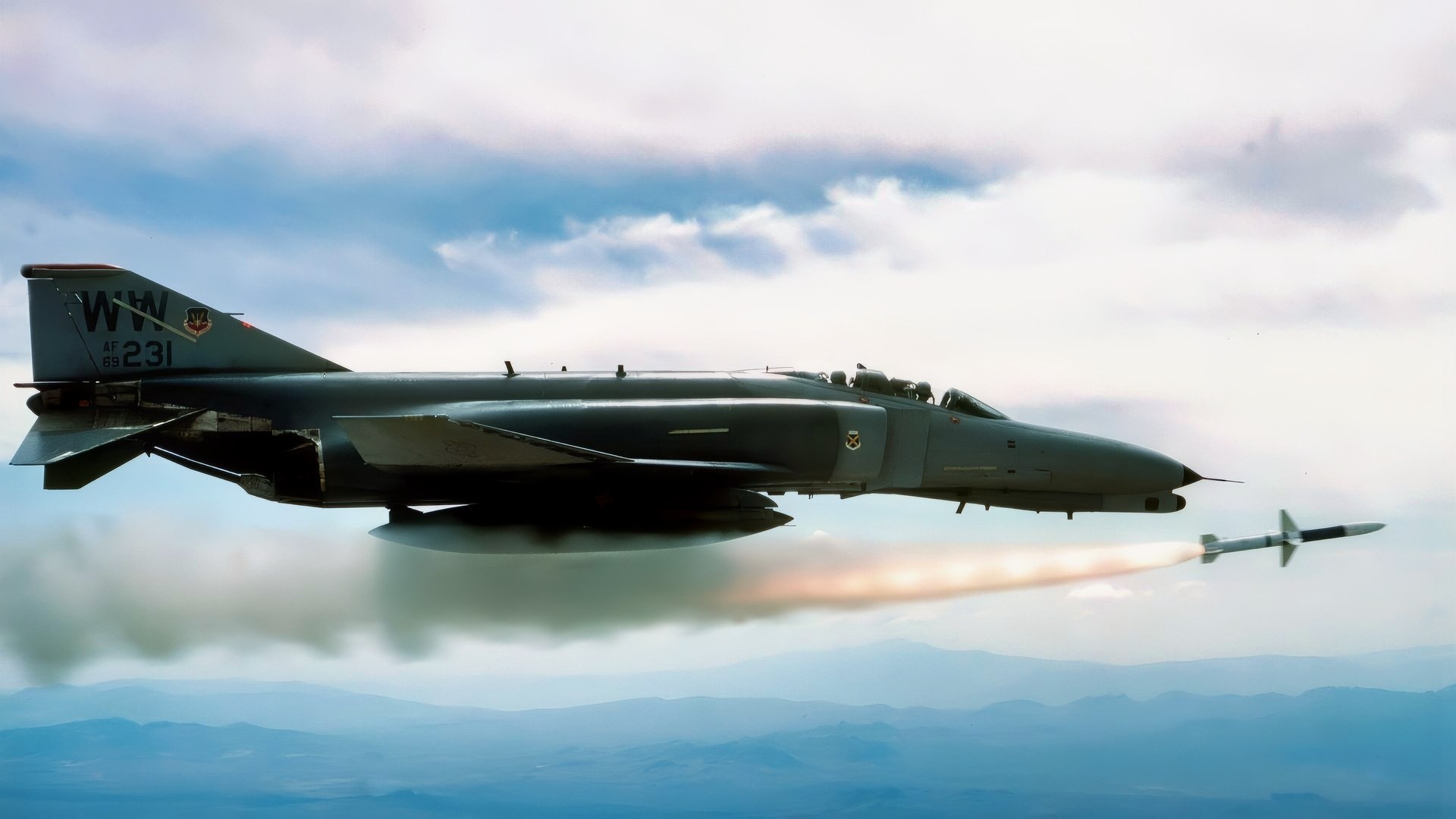Article Summary – The F-4G Wild Weasel was the U.S. Air Force’s dedicated SAM-killer, born in Vietnam when Soviet-built missiles began mauling American airpower.
-Evolving from early F-105 and F-4C conversions into the purpose-built F-4G, the Wild Weasel traded its cannon for powerful receivers, jammers, and anti-radiation missiles like Shrike and HARM.

F-4G Wild Weasel. Photo Credit: Harry J. Kazianis, National Security Journal.
-Crews—pilot and electronic warfare officer—flew “first in, last out,” drawing enemy radars to fire and then killing them.
-In Desert Storm, F-4Gs flew nearly 4,000 sorties and shattered Iraqi air defenses, enabling the air campaign’s “turkey shoot.” Retired in 1996, the Wild Weasel remains the gold standard for SEAD.
-BONUS – All images in the text of this article are from a National Security Journal visit to the U.S. Air Force Museum back in July.
The F-4G Wild Weasel Was A Legend
An airplane nicknamed the “Wild Weasel” should bring a smile to your face, but this strike aircraft was deadly serious with a critical mission.
The Wild Weasel was a converted F-4E Phantom II that flew in beast mode to eliminate enemy air defenses.
It cleared the way for the other Phantoms to blast at military targets or provide close air support.
Why Were Wild Weasels Needed So Badly
The F-4G Wild Weasel had its cannon removed and replaced with AN/APR-47 electronic warfare jammers. During the Vietnam War, the enemy’s surface-to-air missiles were taking a grave toll on friendly fighters.

F-4G Side of Plane. Image Credit: National Security Journal.
There had to be a way to counteract these air defenders and save the pilots who kept getting shot down.
The Wild Weasel program was designed to suppress enemy air defenses by first spoofing radar and then using missiles to take out SAM sites.
The Wild Weasel program initially comprised F-105 F/Gs performing the suppression role; later, the F-4C was converted to execute the Wild Weasel role.
“Efforts to make the F-4C a Wild Weasel aircraft started in 1966, but developmental problems prevented it from being fielded until the spring of 1969. One F-4C Wild Weasel unit, the 67th TFS at Kadena Air Base, Okinawa, sent six F-4C Wild Weasels to Korat, Thailand, in September 1972. Used in southern North Vietnam during Linebacker, the F-4C Wild Weasel aircrews effectively supported strikes around Hanoi during Linebacker II, flying 460 sorties in Southeast Asia without loss,” according to an Air Force history paper from the national museum.
The F4-G Entered the Picture
F-4Gs were later equipped with AGM-88A/B/C High Speed Anti-Radiation Missiles (HARM).
The HARMs were high-quality weapons that could punish enemy sensors and blind the SAMs for follow-on attacks.

F-4G Wild Weasel in Museum. Image Credit: National Security Journal/All Rights Reserved.
The Wild Weasel had a pilot and an electronic warfare officer. This person was extremely important in conducting the anti-SAM role.
The Wild Weasel was all about teamwork. Due to the airframe and communications similarities, it was outfitted to work in tandem with the Phantom and later strike airplanes in future wars. Interoperability was excellent, and the Wild Weasel performed its job with high skill and effectiveness.
Wild Weasel Tactics Evolved
Suppressing enemy air defenses became increasingly crucial as the Vietnam War progressed. When the Weasels first started, they used rockets to mark SAM sites for follow-on attacks by other fighters and bombers.
The AGM-45 Shrike anti-radiation missile allowed the Weasels to go directly after the SAMs. The airplanes had a dangerous mission as the first airplanes to engage in battle.
“Thirty-four Wild Weasel crews were killed or went missing in action during the Vietnam War, and 19 became prisoners of war,” according to the Tales in the Cockpit YouTube channel.
During the Cold War, the Wild Weasel Could Have Flown Hot
After Vietnam, the F-4G became the Wild Weasel platform to suppress Soviet air defenses in the late 1970s. The F-4G was outfitted with the AGM-45 Shrike or the AGM-88 HARM. The F-4G was the only airplane in the Air Force that was formally designated for the suppression of enemy air defenses role.
Wild Weasel Dominates During Operation Desert Storm
It was during the First Gulf War that the F-4G Wild Weasel really shone.
The F-4Gs were extremely busy. “F-4G Advanced Wild Weasels from the 35th Tactical Fighter Wing at George Air Force Base, Calif., and the 52nd TFW at Spangdahlem, Germany, flew 3,942 combat sorties, fired 1,000 air-to-ground missiles, and destroyed 200 Iraqi missile sites,” the Defense Media Network wrote.
The follow-on attacks by fighters and bombers during Operation Desert Storm would not have been as successful without the Wild Weasel.
This type of warfare created an environment where the Air Force could engage in a “turkey shoot” to eliminate Iraqi tanks and armored personnel carriers from strike airplanes like the A-10 Warthog.
Most of the time, the Wild Weasels would destroy Iraqi SAMs like the SA-2 and SA-3. The F-4Gs were instrumental in attritting Saddam Hussein’s air defenders until the armored vehicles could be destroyed with ease without the worry of the SA-2 and SA-3.
When I earlier mentioned beast mode, I wasn’t kidding. In Operation Desert Storm, the F-4G “carried a centerline and two under-wing external fuel tanks.
It carried an AN/APR-47 RHAW (radar homing and warning) system in a chin pod beneath its nose instead of the usual M61 Vulcan 20 mm rotary cannon, an AN/ALQ-119 jamming pod in the left forward missile well, an empty right missile well, and a pair of AIM-7 Sparrow radar missiles in the rear wells.
It carried chaff and flares, and its principal war-load was two AGM-88 High-speed Anti-Radiation Missiles (HARMs) hanging from outboard weapons stations,” the Defense Media Network said.
This all weighed about 58,000 pounds, so the Wild Weasel needed powerful General Electric J79-GE-17 turbojet engines with afterburners.
The Wild Weasel could be refueled in the air for the long journey from Bahrain to Baghdad. After SA-2s and SA-3s were destroyed, F-4G crews went after advanced SA-6 SAMs. The Wild Weasels destroyed 74 percent of enemy radar and air defense systems during Operation Desert Storm.
The F-4G Wild Weasel was finally retired in 1996. You can still see one model from the 35th Tactical Fighter Wing, George Air Force Base, that fired more than 40 missiles in the First Gulf War. It sits at the National Museum of the U.S. Air Force at Wright-Patterson Air Force Base in Ohio.
The Wild Weasel program was sometimes costly but overall very successful – especially in the 1990s. Blinding enemy radar and taking out their SAMs was the essence of air war and paved the way for much success.
The Weasels were “first in and last out” during aerial combat missions, and other Air Force pilots were thankful for their significant roles in protecting numerous aviators over the decades.
About the Author: Brent M. Eastwood
Author of now over 3,000 articles on defense issues, Brent M. Eastwood, PhD is the author of Don’t Turn Your Back On the World: a Conservative Foreign Policy and Humans, Machines, and Data: Future Trends in Warfare plus two other books. Brent was the founder and CEO of a tech firm that predicted world events using artificial intelligence. He served as a legislative fellow for US Senator Tim Scott and advised the senator on defense and foreign policy issues. He has taught at American University, George Washington University, and George Mason University. Brent is a former US Army Infantry officer. He can be followed on X @BMEastwood.










